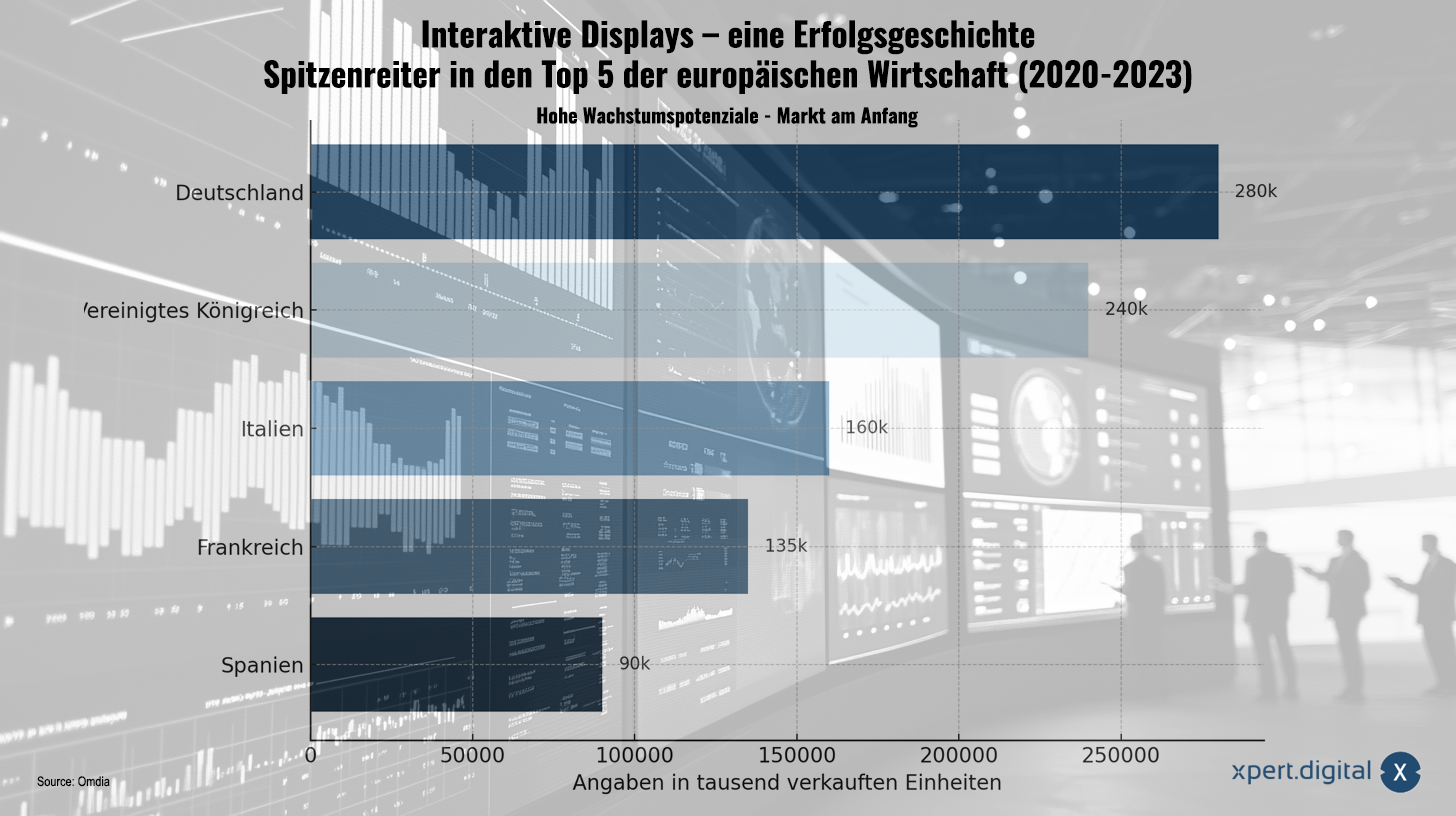
Interactive displays on the rise: trends and insights into the German and European markets – Image: Xpert.Digital
Market analysis: Why interactive displays offer the next big growth potential
Market development for interactive displays in Europe and Germany
The market for interactive screens in Europe, especially in Western Europe, is a dynamic, albeit currently challenging, sector. In the second half of 2023, a decline in sales of 5.3% was recorded compared to the previous year. However, experts see enormous growth potential as the market is not yet fully developed in many regions of Europe, particularly in countries such as France, Italy and Spain. There, both the digitization of schools and the introduction of this technology in companies are only in their early stages. Germany is playing a pioneering role here and has established itself as the leading market in Europe with around 280,000 units sold between 2020 and 2023.
The global interactive display market was valued at an impressive $42.9 billion in 2022 and is forecast to grow to $95.7 billion by 2032. This corresponds to an average annual growth rate of 8.4%. In Europe, growth is primarily driven by the digitalization trend in schools and companies as well as growing demand in sectors such as education, retail and healthcare. This development is a clear indication of the increasing importance of interactive technologies in a wide range of industries.
Suitable for:
Growth drivers and potential in Europe
The European interactive displays market is fueled by several factors that increase its attractiveness for both European and international companies:
1. Digitalization in education
The pandemic has massively accelerated the need for digital learning solutions. Interactive screens are a central element of modern classrooms as they promote collaborative learning and enable seamless integration of digital learning platforms.
2. Enterprise applications
Interactive technologies are also becoming increasingly important in the business world. They are increasingly being used in meeting rooms, for training and in the area of hybrid collaboration. Companies are realizing that such technologies not only increase productivity, but also create a professional image.
3. Impact of technological innovations
Advances in touchscreen technology, AI-powered applications and energy-efficient solutions are making interactive screens increasingly attractive. Customers are increasingly placing value on long-lasting, highly functional products that also meet ecological standards.
4. Availability of funding programs
In many EU countries there are financial incentives to promote digitalization in schools and other areas. These programs are instrumental in ensuring that the market for interactive displays continues to grow.
Strategic opportunities for non-European companies
For non-European companies, the market for interactive screens in Europe offers numerous opportunities that can be exploited through targeted strategies:
Market entry into undeveloped regions
In many European countries the market is still in an early phase of penetration. Non-European companies that offer innovative solutions and competitive prices can do pioneering work here and expand their market presence.
Technology export and innovation
Companies from technologically advanced regions can bring their innovative products and services to the European market. Technologies that meet the needs of European customers, such as interactive whiteboards with AI functions, energy-efficient designs or advanced touch technologies, are particularly in demand.
Cooperations with local partners
Partnerships with European companies can be a successful market strategy. These collaborations not only enable easier market access, but also promote the development of tailor-made solutions that meet the specific needs of local customers.
Adaptation to local requirements
The European market demands solutions that take cultural and regulatory differences into account. Non-European companies can score points here by developing products that meet the specific expectations of European customers, be it through better usability, multilingual support or sustainable production methods.
Challenges and solutions
Despite the great potential, companies looking to enter the European interactive display market also face some challenges:
1. Regulatory requirements
In Europe there are strict regulations regarding product safety, data protection and energy efficiency. Non-European companies must ensure that their products meet these standards in order to be successful.
2. Cultural differences
The European market is not homogeneous. Each country has its own requirements, preferences and market conditions. However, companies that develop a differentiated market access strategy can benefit from this diversity.
3. Competitive pressure
European manufacturers and established global brands are putting pressure on the market. Clear differentiation through innovation, quality and service is essential to stand out from the competition.
4. Sustainability and environmental protection
European customers attach great importance to environmentally friendly products. Non-European companies can gain additional market share through sustainable designs and energy-efficient solutions.
A variety of opportunities for companies
Despite short-term declines, the European market for interactive screens is a growth market with enormous potential. The increasing digitalization in education and business as well as the demand for technological innovations are creating a variety of opportunities for companies that want to enter this market. Non-European companies can strengthen their position in this market and benefit from its dynamic growth through strategic investments, targeted partnerships and tailor-made solutions.
As the market evolves, competition will also increase. However, companies that focus on innovation, quality and sustainability early on can be successful in the long term and expand their market shares. As a market for interactive screens, Europe offers an exciting environment that rewards technological pioneers and visionary strategists in equal measure.
Suitable for:
